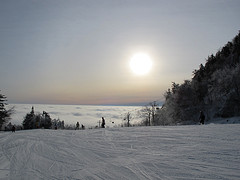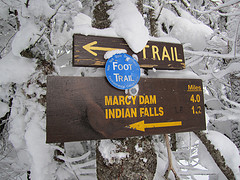“...not to exceed a total of three hundred acres of state forest preserve land, nor from constructing and maintaining not more than twenty-five miles of ski trails thirty to two hundred feet wide, together with appurtenances thereto, provided that no more than five miles of such trails shall be in excess of one hundred twenty feet wide, on the north, east and northwest slopes of Whiteface Mountain in Essex county..."
-Article XIV of the New York State Constitution
Resort skiing has been the subject of extensive legislation. Though not written into the initial version of Article XIV, once added, it ensured government regulation of Adirondack Skiing. While Whiteface has been labeled an intensive use area, it still boarders wilderness lands, and thus is subject to certain regulations regarding

size and maintenance. After the development boom resulting from the 1980 Winter Olympics, the Department of Environmental Conservation (DEC) created the Olympic Regional Development Authority (ORDA) in 1982 and tasked them exclusively with overseeing the appropriate maintenance and regulation of Whiteface,Gore Mountain, and other Olympic facilities. According to the ORDA website, their direct constitutional instruction is to “institute coordinated program of activities” to facilitate year-round use of the facilities (ORDA, 2014). As a follow up to that, the management of all such programs and the activities they draw is their responsibility, as directly codified in New York State Legislation.
While ski resorts were granted exception to the forever Wild clause, backcountry skiing received no mention, and is not currently listed as an acceptable activity within Wilderness and Wild Forest areas. Organizations of backcountry enthusiasts see the upcoming revision to the State Land Master Plan (SLMP) as an opportunity to formally recognize and maintain their sport and culture within the park. The Adirondack Powder Skier Association (APSA) is one such collective at the forefront of a possible revision. Led by seasoned Adirondack veteran Ron Konowitz, the APSA is advocating the creation and maintenance of sustainable

backcountry ski trails throughout certain areas of the park as a government-run commodity (in a similar fashion to current hiking and snowshoeing trials). They claimthey only need to clear brush without cutting any trees, a process which is much less environmentally intrusive than the cutting needed to establish hiking trails (Rogge, 2013). Because they only plan to cut brush, an action analgous (or less harmful) than creating hiking trails, the APSA is hopeful that the plan will not require an amendment, but rather just a the mentioning of backcountry skiing as a recognized activity. Proponents of the new legislation see an opportunity to boost eco-friendly tourism without clear cutting or promoting extensive resorts such as the proposed Big Tupper resort. In this manner, government control of backcountry skiing would foster the culture of backcountry skiing which for so long has drawn people to the mountains. The rugged, remote terrain would remain as such, and the historic intensity of locals like Ron Konowitz and the Ski-to-Die club would be preserved from degredation due to expansion and popularization.
